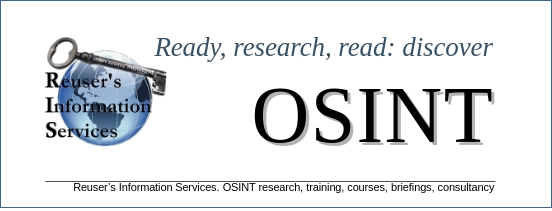Essential OSINT reading for this week.
Building your information position on OSINT is essential when you are in the OSINT world. In Ready, Research, Read I shall share on a weekly basis one or two titles that I consider very worth while reading, based on working in OSINT since 1990. Let me know your thoughts.
Open source intelligence : an overview of today’s operational challenges and human rights affected as a consequence / Perez, Ainara Bordes . – In: Intelligence and Security in the 21st Century , 2023
Refs. This rapid evolution of OSINT capabilities has nonetheless opened the debate surrounding the potential risks new means and uses of OSINT can involve for human rights. OSINT has traditionally been perceived as having no impact on human rights, and apart from information security and intellectual property issues, the (side) effects of OSINT have received little attention in the literature until recently (Eijkman & Weggemans, 2013, p. 289) However, the new OSINT setting is both qualitatively and quantitatively different from the “traditional” OSINT, and the potential impacts of the new techniques are also new. This report aims at studying those impacts, focusing on the risks deriving from technical and practical challenges of the OSINT process as we know it today
Artificial intelligence, deepfakes, and disinformation : a primer / Helmus, Todd C. : RAND Corporation , 2022 . – (Perspective)
OSINTs, as well as journalistic tools and tradecraft, provide additional approaches to addressing the deepfake problem. The goal with these approaches is to develop and share open-source tools that can be used to identify deepfakes and other disinformation-related content. These and a variety of other emerging tools are particularly important for journalists representing small to midsize news organizations, who will need to rely on such open-source tools to verify authenticity of reported content. OSINTs and related tools will also be important to a variety of civil society actors who engage in fact-checking and other educational work.
OSINT from a UK perspective : considerations from the law enforcement and military domains / Wells, Douglas ; Gibson, Helen . – In: From research to security union proceedings , 2017
Both law enforcement and the military have incorporated the use of open source intelligence (OSINT) into their daily operations. Whilst there are observable similarities in how these organisations employ OSINT there are also differences between military and policing approaches towards the understanding of open source information and the goals for the intel- ligence gathered from it. In particular, we focus on evaluating potential similarities and differences between understandings and approaches of operational OSINT between British law enforcement agencies and UK based MoD researchers and investigators. These observations are gath- ered towards the aim of increasing interoperability as well as creating opportunities for specific strengths and competencies of particular organisational approaches to be shared and utilised by both the military and law enforcement
Remember, OSINT is a very broad and general concept that applies to many different areas. That explains why there are so many different definitions and visions. It is up to you to derive what is useful in your own environment.
Want to read more? Consider the OSINT Treasure Trove, a bibliography devoted to the finer art of OSINT.
Happy reading!

